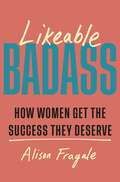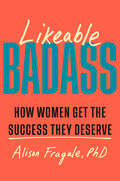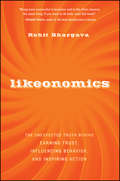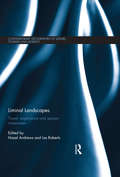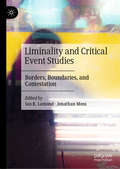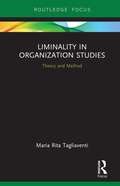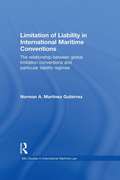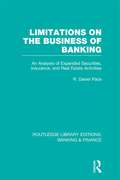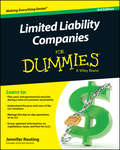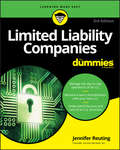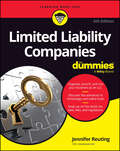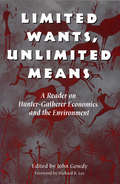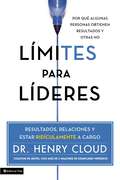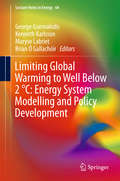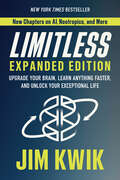- Table View
- List View
Likeable Badass: How Women Get the Success They Deserve
by Alison Fragale'Will help you do the best work of your life' Kim Scott, bestselling author of Radical Candor'A must-read' Adam Grant, bestselling author of Think Again'With warmth, humour, and powerful personal stories, Fragale provides women with actionable advice for achieving greater success in the workplace' Sheryl Sandberg, bestselling author of Lean InWant to earn credit for your accomplishments, negotiate better, and navigate complex office politics while still being liked by your colleagues? Likeable Badass is the ultimate guide to advance in any workplace, full of tips, tricks, and strategies to help you get the success you deserve.Many women's workplace issues boil down to status. No amount of power-- no degree, title, or salary-- will raise a woman's workplace stature unless it also affects how others perceive her. Acknowledging this roadblock, behavioural scientist Alison Fragale pulls back the curtain on how we can change how others see us by developing our standing as a "likeable badass." Through cultivating perceptions of warmth and assertiveness, women can achieve the kind of reputation that leads to a seat at the table and a fulfilling career path.Likeable Badass weaves together powerful new insights with actionable advice and impactful stories from a diverse array of women. This is a warm, heartening book written for women, their allies, and anyone who struggles to rise, and wants evidence-based, practical strategies for success.
Likeable Badass: How Women Get the Success They Deserve
by Alison Fragale'Will help you do the best work of your life' Kim Scott, bestselling author of Radical Candor'A must-read' Adam Grant, bestselling author of Think Again'With warmth, humour, and powerful personal stories, Fragale provides women with actionable advice for achieving greater success in the workplace' Sheryl Sandberg, bestselling author of Lean InWant to earn credit for your accomplishments, negotiate better, and navigate complex office politics while still being liked by your colleagues? Likeable Badass is the ultimate guide to advance in any workplace, full of tips, tricks, and strategies to help you get the success you deserve.Many women's workplace issues boil down to status. No amount of power-- no degree, title, or salary-- will raise a woman's workplace stature unless it also affects how others perceive her. Acknowledging this roadblock, behavioural scientist Alison Fragale pulls back the curtain on how we can change how others see us by developing our standing as a "likeable badass." Through cultivating perceptions of warmth and assertiveness, women can achieve the kind of reputation that leads to a seat at the table and a fulfilling career path.Likeable Badass weaves together powerful new insights with actionable advice and impactful stories from a diverse array of women. This is a warm, heartening book written for women, their allies, and anyone who struggles to rise, and wants evidence-based, practical strategies for success.
Likeable Badass: How Women Get the Success They Deserve
by Alison FragaleBehavioral scientist Alison Fragale offers powerful new insights and a practical playbook for women to advance in any workplace, full of tips, tricks, and strategies to help secure that elusive corner office.Over decades of research, speaking engagements, and mentorship, psychologist and professor Alison Fragale encountered recurring questions from high powered and early career women alike: How do women thread the needle of kindness and competence in the workplace? How can women earn credit for their accomplishments, negotiate better, and navigate complex office politics without losing the goodwill of their peers?Fragale investigated and determined that many women's workplace issues boil down to what psychologists call status: the perception of them by others. No amount of power-- no degree, title, or paycheck-- will raise a woman's workplace stature unless it also affects how others see her. Acknowledging this roadblock, Fragale pulls back the curtain on how we can change how others see us by developing our standing as a "likeable badass." By cultivating perceptions of warmth and assertiveness, women can achieve the kind of reputation that leads to a seat at the table and a fulfilling career path.Likeable Badass is equal parts behavioral science and life hacks, weaving together rigorous research with actionable advice and impactful stories from a diverse array of women. This is a warm, heartening book written for women, their allies, and anyone who struggles to rise, and wants evidence-based, practical strategies for success, served with a side of inspiration and humor.
Likeonomics
by Rohit BhargavaHow to become a trusted resource for consumers in a society of constant manipulationPeople decide who to trust, what advice to heed, and which individuals to forge personal or transactional relationships with based on a simple metric of believability. Success, in turn, comes from understanding one basic principle: how to be more trusted. Likeonomics offers a new vision of a world beyond Facebook where personal relationships, likeability, brutal honesty, extreme simplicity, and basic humanity are behind everything from multi-million dollar mergers to record-breaking product sales. There is a real ROI to likeability, and exactly how big it is will amaze you.Likeonomics provides real-world case studies of brands and individuals that have used these principles to become wildly successful, including:An iconic technology brand that awakened a revolution among their employees by standing for something bigger than their productsA Portuguese singer who used YouTube to rack up more than 30 million views and launch her professional career. A regional team of financial advisors that went from being last in the nation among 176 branches to first, and stayed there for 13 of the next 15 yearsA tiny professional sports talent agent who achieved the impossible by landing the #1 drafted player in the NFL draft as a client through the power of relationshipsAuthor Rohit Bhargava is a founding member of the world's largest group of social media strategists at Ogilvy, where he has led marketing strategy for clients including Intel, Pepsi, Lenovo, Seiko, Unilever, and dozens of other large companiesWith Likeonomics as a guide, readers will get unconventional advice on how to stand out in a good way, avoid the hype and strategic traps of social media, and appeal to customers in a way that secures your company as a trusted and believable resource.
Liking Myself Back: An Influencer's Journey from Self-Doubt to Self-Acceptance
by Jacey DuprieEntrepreneur and lifestyle influencer Jacey Duprie shares her inspiring journey of going from farm girl to fashion icon and her lessons about personal growth and self-made success.With millions of followers and a thriving lifestyle brand, Damsel in Dior, Jacey Duprie is one of today&’s top fashion influencers. Her beautiful Instagram photos capture a life of glamour, luxury and elegance. But Jacey&’s life offline has been far from perfect.In this candid memoir, Jacey reveals that behind her gorgeously curated photos was a woman struggling with deep insecurities. She shares intimate details of a difficult childhood growing up in rural Texas with an alcoholic father and her own battles with PTSD and mental health. Through resilience, hard work and self-reflection, Jacey eventually triumphed to become the strong, empowered woman she is today. In Liking Myself Back, Jacey takes readers behind the scenes into the seductive world of fashion and influencing, and reveals how she overcame hardship to achieve her dreams. With raw emotional honesty, Jacey shows that conquering self-doubt and embracing your imperfect, authentic self is not only possible, but is the true key to happiness.
Lille Tissages, S.A.
by William J. Bruns Jr.The marketing director and finance director must set the price for an expensive yet competitive fabric. Recent price increases have not been matched by competitors, and market share has been lost. The case provides an opportunity to practice contribution analysis considering variable and fixed costs as reported in a typical cost report.
Liminal Landscapes: Travel, Experience and Spaces In-between (Contemporary Geographies of Leisure, Tourism and Mobility)
by Les Roberts Hazel AndrewsIdeas and concepts of liminality have long shaped debates around the uses and practices of space in constructions of identity, particularly in relation to different forms of travel such as tourism, migration and pilgrimage, and the social, cultural and experiential landscapes associated with these and other mobilities. The ritual, performative and embodied geographies of borderzones, non-places, transitional spaces, or ‘spaces in-between’ are often discussed in terms of the liminal, yet there have been few attempts to problematize the concept, or to rethink how ideas of the liminal might find critical resonance with contemporary developments in the study of place, space and mobility. Liminal Landscapes fills this void by bringing together variety of new and emerging methodological approaches of liminality from varying disciplines to explore new theoretical perspectives on mobility, space and socio-cultural experience. By doing so, it offers new insight into contemporary questions about technology, surveillance, power, the city, and post-industrial modernity within the context of tourism and mobility. The book draws on a wide range of disciplinary approaches, including social anthropology, cultural geography, film, media and cultural studies, art and visual culture, and tourism studies. It brings together recent research from scholars with international reputations in the fields of tourism, mobility, landscape and place, alongside the work of emergent scholars who are developing new insights and perspectives in this area. This timely intervention is the first collection to offer an interdisciplinary account of the intersection between liminality and landscape in terms of space, place and identity. It therefore charts new directions in the study of liminal spaces and mobility practices and will be valuable reading for range of students, researchers and academics interested in this field.
Liminality and Critical Event Studies: Borders, Boundaries, and Contestation
by Ian R. Lamond Jonathan MossThis book explores and challenges the concept and experience of liminality as applied to critical perspectives in the study of events. It will be of interest to researchers in event studies, social and discursive psychology, cultural and political sociology, and social movement studies. In addition, it will provide interested general readers with new ways of thinking and reflecting on events. Contributing authors undertake a discussion of the borders, boundaries, and areas of contestation between the established social anthropological concept of liminality and the emerging field of critical event studies. By drawing these two perspectives closer together, the collection considers tensions and resonances between them, and uses those connections to enhance our understanding of both cultural and sporting events and offer fresh insight into events of activism, protest, and dissent.
Liminality in Organization Studies: Theory and Method (Routledge Focus on Business and Management)
by Maria Rita TagliaventiIn a time of flexible and mutable work arrangements, there is hardly a domain of organizing that has not been affected by liminality. Temporary workers who switch companies based on projects, consultants who operate at the boundaries between the consultant and the client companies, or ‘hybrid entrepreneurs’ who start new ventures, while still keeping their previous job, are examples of liminality in organizations. Liminality is also felt by managers who handle interorganizational relationships within customer-supplier networks or scientists who, albeit affiliated with R&D units, have strong ties with their scientific communities, acknowledging that they belong to neither setting thoroughly. Precious hints for enriching our comprehension of liminality in organizational settings can be conveyed by the reflection that has flourished in different fields. This book advances knowledge of liminality management by elaborating on a model that puts together aspects of the liminal process that have been mostly described in a separate way so far, benefiting from the input provided by experience in sociology, medicine, and education. Through the articulation of a model that accounts for the antecedents, content, and consequences of liminality in organizations, the book intends to prompt quantitative research on this topic. It will be of value to those interested in organizational behavior, organization and management, marketing, sociology of work, and sociology of organizations.
Limitarianism: The Case Against Extreme Wealth
by Ingrid Robeyns"A powerful case for limitarianism—the idea that we should set a maximum on how much resources one individual can appropriate. A must-read!" —Thomas Piketty, bestselling author of Capital in the Twenty-First CenturyAn original, bold, and convincing argument for a cap on wealth by the philosopher who coined the term "limitarianism."How much money is too much? Is it ethical, and democratic, for an individual to amass a limitless amount of wealth, and then spend it however they choose? Many of us feel that the answer to that is no—but what can we do about it?Ingrid Robeyns has long written and argued for the principle she calls "limitarianism"—or the need to limit extreme wealth. This idea is gaining momentum in the mainstream – with calls to "tax the rich" and slogans like "every billionaire is a policy failure"—but what does it mean in practice?Robeyns explains the key reasons to support the case against extreme wealth: It keeps the poor poor and inequalities growingIt&’s often dirty moneyIt undermines democracyIt&’s one of the leading causes of climate changeNobody actually deserves to be a millionaireThere are better things to do with excess moneyThe rich will benefit, tooThis will be the first authoritative trade book to unpack the concept of a cap on wealth, where to draw the line, how to collect the excess and what to do with the money. In the process, Robeyns will ignite an urgent debate about wealth, one that calls into question the very forces we live by (capitalism and neoliberalism) and invites us to a radical reimagining of our world.
Limitation of Liability in International Maritime Conventions: The Relationship between Global Limitation Conventions and Particular Liability Regimes (IMLI Studies in International Maritime Law)
by Norman A. Martínez GutiérrezLimitation of liability for maritime claims is a concept of respectable antiquity which is now deeply entrenched in the maritime industry. Under this concept, the shipowner is entitled to limit his liability for maritime claims up to a maximum sum regardless of the actual amount of the claims. The concept of limitation of liability has been adopted by many conventions ranging from those relating to the carriage of goods by sea, carriage of passengers and their luggage by sea, liability and compensation for pollution damage, to liability for the removal of wrecks. Each of these conventions has its own approach to limitation of liability. However, these particular liability regimes share the international arena with global limitation conventions such as the 1976 Convention on Limitation of Liability for Maritime Claims and the 1996 Protocol thereto. This book approaches limitation of liability from an international perspective looking at a number of key conventions including the global limitation conventions, the conventions relating to the carriage of passengers and their luggage by sea (1974 Athens Convention relating to the Carriage of Passengers and Their Luggage by Sea and the 2002 Protocol thereto), conventions relating to liability and compensation for pollution damage (1969 International Convention on Civil Liability for Oil Pollution Damage and the 1992 Protocol thereto, the 1996 International Convention on Liability and Compensation for Damage in Connection with the Carriage of Hazardous and Noxious Substances by Sea and the 2010 Protocol thereto, and the 2001 International Convention on Civil Liability for Bunker Oil Pollution Damage), as well as the 2007 Nairobi International Convention on the Removal of Wrecks. Each chapter of this book sets out to analyze provisions in the conventions which have proved to be controversial and subject to debate by courts and authors, as well as the relationship between the limitation provisions in claim specific liability conventions and in the global limitation conventions. Particular attention is also given to the persons entitled to limit liability, ships in respect of which liability can be limited, claims subject to limitation, claims excepted from limitation, basis of liability (where applicable), loss of the right to limit, and the limits of liability. Limitation of Liability in International Maritime Conventions is of interest to academics and practicing lawyers who wish to understand the intricacies of the law of limitation.
Limitations on the Business of Banking: An Analysis of Expanded Securities, Insurance and Real Estate Activities (Routledge Library Editions: Banking & Finance)
by R Daniel PaceThis book is a study of how expanded bank powers could affect the banking industry in the US. Using contemporaneous measures, expanded data, a finer classification of industries, risk-reducing behavior, and the legal and regulatory environment this volume provides a more complete picture than earlier studies.
Limited Affordable Low-Volume Manufacturing: Summary of a Workshop
by Maureen Mellody"Limited Affordable Low-Volume Manufacturing" is the summary of a workshop convened by the National Materials and Manufacturing Board of the National Research Council in August 2013 to discuss affordable, low-volume manufacturing. The workshop focused on four critical issues relevant to manufacturing: low-volume manufacturing; use of commercial off-the-shelf equipment; short production runs; and commercial manufacturing services. The workshop discussion also considered variable-rate manufacturing and high-mix manufacturing, both aspects of low-volume manufacturing. This report examines the characteristics of low-volume manufacturing and considers future advances in limited affordable low-volume manufacturing in the United States.
Limited Editions, Inc.
by Dennis P. FrolinDescribes a new venture: production of figurines in limited quantities as works of art and investments. Company guarantees to repurchase at original price.
Limited Liability Companies For Dummies
by Jennifer ReutingFlex your entrepreneurial muscle with an LLCThe previous drawbacks to forming an LLC have all but disappeared. The IRS has loosened the restrictions on entities electing partnership taxation and subsequently the states have loosened their requirements. Because LLCs are now more flexible entities than any that have ever existed, they remain an attractive option for those launchinga new or relaunching an existing business.Limited Liabilty Companies For Dummies is a clear, concise guide that explains the pros and cons of LLCs and shares insider insights on everything from choosing your members and your company name to creating and filing your Articles of Organization, to the day-to-day operation of your LLC. Plus, you'll the most current, real-world advice on customizing an LLC for your specific business needs.The latest information on federal taxes and feesNew filing requirements and coverage of setting up real estate LLCs and LLCs among family membersAccompanying CD includes updated tools and formsIt's full-steam ahead for LLCs, and this hands-on guide addresses everything you need to know and more!
Limited Liability Companies For Dummies
by Jennifer ReutingBecome a savvy entrepreneur with your own LLC Limited Liability Companies For Dummies, 3rd Edition offers a clear, concise guide that explains the pros and cons of LLCs, and shares insider tips on everything from choosing your members and your company name to creating and filing your Articles of Organization and managing day-to-day operations. You'll find the most current, real-world advice on customizing an LLC for your specific business needs, creating a great operating agreement, keeping accurate records, and new information on federal regulations and fees that are applicable to LLCs, as well as a link to online tools, forms, and documents Most of the previous drawbacks to forming an LLC have all but disappeared with the IRS having loosened restrictions and individual states following suit. Because LLCs are now more flexible, they remain an attractive option for those launching a new business or reorganizing an existing business. This book shows how to form and tap into the power of an LLC: Keep up on the latest information on federal taxes, regulations, and fees Discover the advances in technology, including online tools that streamline the processes Get up-to-the minute documents and forms on new filing requirements Learn how to set-up a real estate LLC or an LLC among family members This hands-on guide addresses everything you need to know about LLCs, and will help you organize, launch, and run your business as a limited liability company just like the experts do!Limited Liability Companies For Dummies, 3rd Edition (9781119602187) was previously published as Limited Liability Companies For Dummies, 3rd Edition (9781118852989). While this version features a new Dummies cover and design, the content is the same as the prior release and should not be considered a new or updated product.
Limited Liability Companies For Dummies
by Jennifer ReutingThere’s no better time than now to start a new business and tap into the power of the LLC LLCs For Dummies is your comprehensive guide to limited liability companies. You’ll explore whether an LLC is the right business structure for your business, how to set up a corporate structure and membership, and the best ways of managing an LLC. Author Jennifer Reuting explains the pros and cons of LLCs and shares insider tips on choosing members, selecting a company name, creating and filing Articles of Organization, managing day-to-day operations, and beyond. This updated edition covers all the latest tax and regulatory information, plus new laws that make it more attractive than ever to start your own business. You’ll also find real-world advice on customizing your LLC for your specific business needs, creating a great operating agreement, keeping accurate records, and filing the proper paperwork with Uncle Sam. Learn to start a new business by founding a limited liability company (LLC) Get a handle on the differences between LLCs and other business structures, including state-specific tips Keep up on the latest information on federal taxes, regulations, and fees Discover online tools, new documents and forms, and helpful resourcesAnyone who wants to learn the best practices of LLC formation, management, and long-term growth will love this beginner-friendly Dummies guide.
Limited Wants, Unlimited Means: A Reader On Hunter-Gatherer Economics And The Environment
by John GowdyFor roughly 99% of their existence on earth, Homo sapiens lived in small bands of semi-nomadic hunter-gatherers, finding everything they needed to survive and thrive in the biological richness that surrounded them. Most if not all of the problems that threaten our own technologically advanced society -- from depletion of natural capital to the ever-present possibility of global annihilation -- would be inconceivable to these traditional, immediate-return societies. In fact, hunter-gatherer societies appear to have solved problems of production, distribution, and social and environmental sustainability that our own culture seems incapable of addressing.Limited Wants, Unlimited Means examines the hunter-gatherer society and lifestyle from a variety of perspectives. It provides a brief introduction to the rich anthropological and sociological literature on non-agricultural societies, bringing together in one volume seminal writings on the few remaining hunter-gatherer cultures including, the !Kung, the Hadza, and the Aborigines. It examines the economics of traditional societies, and concludes with a multifaceted investigation of how such societies function and what they can teach us in our own quest for environmental sustainability and social equality.Limited Wants, Unlimited Means is an important work for students of cultural anthropology, economic anthropology, environmental studies, and sustainable development, as well as for professionals, researchers, and anyone interested in prehistoric societies, environmental sustainability, or social justice.
Limited-dependent and Qualitative Variables in Econometrics
by G. S. MaddalaThis book presents the econometric analysis of single-equation and simultaneous-equation models in which the jointly dependent variables can be continuous, categorical, or truncated. Despite the traditional emphasis on continuous variables in econometrics, many of the economic variables encountered in practice are categorical (those for which a suitable category can be found but where no actual measurement exists) or truncated (those that can be observed only in certain ranges). Such variables are involved, for example, in models of occupational choice, choice of tenure in housing, and choice of type of schooling. Models with regulated prices and rationing, and models for program evaluation, also represent areas of application for the techniques presented by the author.
Limites para lideres: Resultados, relaciones y estar ridículamente a cargo
by Henry CloudEn 1992, el Dr. Henry Cloud publicó «Límites» el cual vendió más de 2 millones de ejemplares en Inglés. En el transcurso de la última década, el trabajo del Dr. Cloud se ha expandido para incluir actividades de entrenamiento con líderes de empresas. Ha encontrado que el concepto de límites es especialmente impactante en grupos de empresarios, por lo que aquí, en «Límites para los líderes», aplica los mismos principios de límites utilizados en el lugar de trabajo, mostrando así a los líderes cómo utilizar estas herramientas y técnicas para desarrollar una cultura organizativa, para crear expectativas de rendimiento conjunto, liderar equipos, clarificar valores y administrar sus propios comportamientos. ¿Qué es un límite? En pocas palabras, un límite es una línea de propiedad. Define dónde termina una cosa y comienza la otra. Da estructura e identidad. Define la propiedad, el control y responsabilidad. Establece límites sobre las conductas y actividades que se permitirán en dicha propiedad. Del mismo modo, el éxito de un líder depende de la manera en que los límites son delineados y definidos. Y cuando los líderes establecieron límites apropiados, las organizaciones prosperan. «Límites para Líderes», es una lectura esencial para ejecutivos y líderes aspirantes, a aquellos que quieren crear empresas exitosas, con empleados y clientes satisfechos, y ser más resistentes ante las presiones.
Limiting Central Bank Credit to the Government
by Carlo CottarelliA report from the International Monetary Fund.
Limiting Global Warming to Well Below 2 °C: Energy System Modelling and Policy Development (Lecture Notes In Energy #64)
by George Giannakidis Maryse Labriet Kenneth Karlsson B. Ó GallachóirThis book presents the energy system roadmaps necessary to limit global temperature increase to below 2°C, in order to avoid the catastrophic impacts of climate change. It provides a unique perspective on and critical understanding of the feasibility of a well-below-2°C world by exploring energy system pathways, technology innovations, behaviour change and the macro-economic impacts of achieving carbon neutrality by mid-century. The transformative changes in the energy transition are explored using energy systems models and scenario analyses that are applied to various cities, countries and at a global scale to offer scientific evidence to underpin complex policy decisions relating to climate change mitigation and interrelated issues like energy security and the energy–water nexus. It includes several chapters directly related to the Nationally Determined Contributions proposed in the context of the recent Paris Agreement on Climate Change. In summary, the book collates a range of concrete analyses at different scales from around the globe, revisiting the roles of countries, cities and local communities in pathways to significantly reduce greenhouse gas emissions and make a well-below-2°C world a reality. A valuable source of information for energy modellers in both the industry and public sectors, it provides a critical understanding of both the feasibility of roadmaps to achieve a well-below-2°C world, and the diversity and wide applications of energy systems models. Encompassing behaviour changes; technology innovations; macro-economic impacts; and other environmental challenges, such as water, it is also of interest to energy economists and engineers, as well as economic modellers working in the field of climate change mitigation.
Limiting Oil Imports: An Economic History and Analysis (RFF Energy Policy Set)
by Milton Russell Douglas R. BohiFirst Published in 2011. This book presents the results of the third phase of our analysis of U.S. oil imports in relation to U.S. energy policy. It presents a definitive history and analysis of the United States' experiment with formal oil import controls and addresses three questions: The first is how the U.S. energy situation, especially energy security, was affected by what was going on in the rest of the world. The second is the more narrow issue of what energy security options appeared available to the United States from the perspective of the special conditions which existed during 1974-75. The third question, the main subject of this book, and the one with which we initially began, was what lessons might be learned from earlier efforts to limit imports, especially through the Mandatory Oil Import Program.
Limiting Resources: Market-Led Reform and the Transformation of Public Goods (G - Reference, Information and Interdisciplinary Subjects)
by LaDawn HaglundThe provision of public goods such as education, electricity, health, sanitation, and water used to be regarded as primarily the responsibility of governments, but in the 1980s privatization of such services spread and reliance on market mechanisms instead of governments became common in many parts of the world, including developing countries. The record of the past twenty-five years of market-led development, however, has not been encouraging. Not only has it failed to improve public services significantly, but it has also undermined democratic institutions and processes, reproduced authoritarian relations of power, and suppressed alternatives made possible by an increasing global acceptance of the importance of economic and social rights. In Limiting Resources, LaDawn Haglund seeks an understanding of public goods that can better serve the needs of people in developing countries today.Haglund critiques the narrow conception of public goods used in economics, which tends to limit the range of resources considered “public,” and proposes an expanded conception drawing from multiple disciplines that incorporates issues of justice, inclusion, and sustainability. She then uses case studies of electricity and water provision in Central America to illuminate the conditions for success and the causes of failure in constructing adequate mechanisms for the supply of public goods. She follows with an analysis of political conflicts over privatization that reveals how neoliberal policies have made effective state action difficult. The book concludes with suggestions for ways in which this reformulated conception of public goods can be applied to promote justice, sustainability, and economic and social rights in developing countries.
Limitless Expanded Edition: Upgrade Your Brain, Learn Anything Faster, and Unlock Your Exceptional Life
by Jim KwikBrand-new tools to unlock your brain&’s potential! This expanded edition of the New York Times and #1 Wall Street Journal bestseller includes chapters on A.I., nootropics, discovering your brain type, and more.For over 30 years, Jim Kwik, the world-renowned brain coach, has been the secret weapon of success for a diverse range of high achievers, including actors, athletes, CEOs, and business pioneers. In Limitless, he reveals science-based practices and field-tested tips to accelerate self-learning, communication, memory, focus, recall, and speed reading to create amazing results.In this expanded edition, you&’ll find four new chapters:How to harness A.I. (Artificial Intelligence) to boost H.I. (Human Intelligence) The latest breakthroughs in nootropics and nutrition to enhance cognitive performanceLimitless at Work–tools to adapt and thrive, whether you&’re fully remote, embracing the hybrid model, or resuming the traditional office settingA self-assessment to crack your &“brain animal&” codeNewly updated with transformative success stories from people who&’ve used Jim&’s teaching in the real world, the expanded edition of Limitless gives people the ability to accomplish more—more productivity, more transformation, more personal success, more business achievement—by changing their Mindset, Motivation, and Methods and creating unstoppable Momentum. These &“4 M&’s&” live in the pages of Limitless along with practical techniques that unlock the superpowers of your brain and change your habits.Learn how to:FLIP YOUR MINDSET - Identify and challenge the assumptions, habits, and procrastinations that limit you and expand the boundaries of what you believe is possible. IGNITE YOUR MOTIVATION - Uncovering what motivates you is the key that opens up limitless mental capacity. When you unleash your passions, purposes, and sources of energy, you stay focused and clear on your goals. MASTER THE METHODS - Accelerate learning, improve memory, and enhance brain performance. Jim Kwik applies the latest neuroscience for accelerated learning so you can finish a book 3x faster through speed reading (and remember it), learn a new language in record time, and master new skills with ease. BUILD MOMENTUM - Unstoppable momentum is the product of mindset, motivation, and methods. Jim offers new insights and tools to unlock the first 3 M&’s so you can become truly limitless. Limitless Expanded Edition is the ultimate brain training book, packed with practical techniques to help you level up your mental performance and transform your life.&“There&’s no genius pill, but Jim gives you the process for unlocking your best brain and brightest future.&” — Mark Hyman, M.D.

